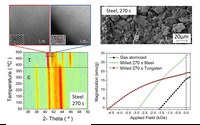New Exchange-Coupled Manganese-Based Magnetic Materials - NEXMAG
NEXMAG project has managed to cover successfully scientific research and technological development in the field of rare earth-free permanent magnets. In addition to scientific highlights achieved on the MnAl system, a patent focused on a functional prototype has been filled, and the world-leading manufacturer of metal powders –Höganäs AB (Sweden)– has established an on-going industrial collaboration for implementation and up-scaling of some of NEXMAG’s results.
Permanent magnets (PMs) are a crucial element in several high-tech markets such as energy and transport sectors, medical technologies and a broad range of electronic products. In addition, PMs play a very important role in efforts focused on an increased use of low carbon technologies to ensure a high living standard. However, most of nowadays-technological PMs contain critical raw materials (rare-earths) as fundamental constituents and EU does not own the natural resources, which might result in a future bottleneck to the supply-chain.
NEXMAG has focused on the development of PM properties in Mn-based alloys: MnAl and MnBi. MnAl is an interesting PM candidate based on excellent theoretically predicted PM properties, low-density, low-cost and abundance of Mn and Al, together with good mechanical properties. MnBi offers excellent PM properties at high temperatures mainly intended for specific low-volume applications demanding high-magnetic performance under those conditions.
Highlights of the project can be summarized as follows:
- Development of PM properties in gas-atomized MnAl particles by nanostructuration with unprecedented short milling times by application of an “ultrafast-milling” method: 30 – 270 s (vs 20-30 h typically reported).
- Tuning microstructure and phase transformation by ultrafast-milling and cryomilling followed by a single-annealing step makes possible to go from a multiphase phase to a ferromagnetic single-phase MnAl system, with customized PM properties. This has been proven on bulk alloy, gas-atomized particles and melt-spun ribbons.
- Establishment of the correlation between morphological, microstructural and magnetic properties, which allows the development of high-coercive (above 5 kOe) isotropic nanocrystalline MnAl powder.
- Development of particulate and continuous MnBi thin films with a coercivity of 29 kOe at 500 K, counting among the largest reported ones for the MnBi system.
- Production of MnAl/metal nanocomposites with enhanced magnetization by matching complimentary properties of dissimilar materials.
- First reported results on the fabrication of MnAl/polymer composites for 3D-printing of novel permanent magnets.
These achievements have led to results of relevance from both scientific and technological points of view:
Dissemination:
- Invitation by the EU Commission to share its stand at the EuroScience Open Forum (ESOF)-2016 held in Manchester. A prototype using MnAl material was presented to the assistants.
- Presence in the media reporting the first time fabrication by IMDEA of an extruded continuous magnetic filament (12 m long) of MnAl for 3D-printing technologies:
https://www.azom.com/news.aspx?newsID=49377
https://www.nanowerk.com/news2/gadget/newsid=50681.php
Patent (Ref. EP16382224):
“System to obtain three-dimensional information from the magnetic field generated by an external permanent magnet source with applications in: detection of structural instabilities in civil engineering, advanced security ID cards and biomedical applications”.
Impact on EU industrial leadership:
- The results obtained in NEXMAG have led to an industrial project with the company Höganäs AB (Sweden). This projects focuses on the up-scaled production of a new generation of rare earth-free permanent magnet material.
- The advances done in the field of 3D-printing of metal/polymer composites have extended the research to an industrial collaboration with the company RAMEM S.A. (Spain).
Relevant publications:
- Rial, P. Švec, E.M. Palmero, J. Camarero, P. Švec Sr. and A. Bollero, “Severe tuning of permanent magnet properties in gas-atomized MnAl powder by controlled nanostructuring and phase transformation”, Acta Mater. 157, 42 (2018).
- M. Palmero, J. Rial, J. de Vicente, J. Camarero, B. Skårman, H. Vidarsson, P.-O. Larsson and A. Bollero, “Development of permanent magnet MnAlC/polymer composites and flexible filament for bonding and 3D-printing technologies”, Sci. Technol. Adv. Mater., 19 (1), 465 (2018).
- Janotová, P. Švec Sr., P. Švec, I. Mat�ko, D. Janičkovič, B. Kunca, J. Marcin and I. Škorvánek, “Formation of magnetic phases in rapidly quenched Mn-Based systems”, J. Alloys Compd. 749, 128 (2018).
- E. Céspedes, M. Villanueva, C. Navío, F. J. Mompeán, M. García-Hernández, A. Inchausti, P. Pedraz, M. R. Osorio, J. Camarero and A. Bollero, “High coercive LTP-MnBi for high temperature applications: from isolated particles to film-like structures”, J. Alloys Compd. 729, 1156 (2017).

Project Details
| Publication date | 2018/09/13 |
|---|---|
| Call Topic | Materials for Sustainable and Affordable Low Carbon Energy Technologies (Call 2014) |
| Duration in months | 36 |
| Partners |
|
| Funded by | |
| Total project cost | 865,333 € |
| Contact | IMDEA Nanociencia
C/ Faraday 9, 28049 Madrid, Spain Prof. Alberto BolleroEmail: alberto.bollero@imdea.org Phone: +34 91 299 8758 |
| Link to ERA-LEARN | View on ERA-LEARN website |
